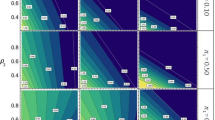Summary
The effect of inbreeding on mean and genetic covariance matrix for a quantitative trait in a population with additive and dominance effects is shown. This genetic covariance matrix is a function of five relationship matrices and five genetic parameters describing the population. Elements of the relationship matrices are functions of Gillois (1964) identity coefficients for the four genes at a locus in two individuals. The equivalence of the path coefficient method (Jacquard 1966) and the tabular method (Smith and Mäki-Tanila 1990) to compute the covariance matrix of additive and dominance effects in a population with inbreeding is shown. The tabular method is modified to compute relationship matrices rather than the covariance matrix, which is trait dependent. Finally, approximate and exact Best Linear Unbiased Predictions (BLUP) of additive and dominance effects are compared using simulated data with inbreeding but no directional selection. The trait simulated was affected by 64 unlinked biallelic loci with equal effect and complete dominance. Simulated average inbreeding levels ranged from zero in generation one to 0.35 in generation five. The approximate method only accounted for the effect of inbreeding on mean and additive genetic covariance matrix, whereas the exact accounted for all of the changes in mean and genetic covariance matrix due to inbreeding. Approximate BLUP, which is computable for large populations where exact BLUP is not feasible, yielded unbiased predictions of additive and dominance effects in each generation with only slightly reduced accuracies relative to exact BLUP.
Similar content being viewed by others
References
Chevalet C (1971) Calcul a priori, intraet inter-populations des variances et covariances génotypiques entre apparentés quelconques. Ann Genet Sel Anim 3:463–477
Chevalet C, Gillois M (1977) Estimation of genotypic variance components with dominance in small consanguineous populations. In: Pollak E, Kempthorne O, Bailey TB (eds) Proc Int Conf Quant Genet. The Iowa State University Press, Ames, Iowa, pp 271–296
Cockerham CC (1954) An extension of the concept of partitioning hereditary variance for analysis of covariances among relatives when epistasis is present. Genetics 39:859–882
Cockerham CC, Weir BS (1984) Covariances of relatives stemming from a population undergoing mixed self and random mating. Biometrics 40:157–164
DeBoer, IJM, Van Arendonk JAM (1992) Prediction of additive and dominance effects in selected or unselected populations with inbreeding. Theor Appl Genet 84:451–459
Emik LO, Terrill CE (1949) Systematic procedures for calculating inbreeding coefficients. J Hered 40:51–55
Falconer DS (1989) Introduction to quantitative genetics. John Wiley & Sons, New York
Gillois M (1964) Calcul de coefficients d'identité d'après les liens de parenté. In: Communication aux Journées d'études de la Commission de Génétique de la Fédération européenne de Zootechnie, Lisbonn
Harris DL (1964) Genotypic covariances between inbred relatives. Genetics 50:1319–1348
Henderson CR (1976) A simple method for computing the inverse of a numerator relationship matrix used in prediction of breeding values. Biometrics 32:69–83
Hoeschele I, Van Raden PM (1991) Rapid inversion of dominance relationship matrices for noninbred populations by including sire by dam subclass effects. J Dairy Sci 74:557–569
Jacquard A (1966) Logique du calcul des coefficients d'identité entre deux individus. Population 21:751–776
Jacquard A (1974) The genetic structure of populations. Springer, Berlin Heidelberg New York
Quaas RL (1988) Additive genetic models with groups and relationship. J Dairy Sci 71:1338–1345
Robertson A, Hill WG (1983) Population and quantitative genetics of many linked loci in finite populations. Proc R. Soc London Ser B 219:253–264
Smith SP (1984) Dominance relationship matrix and inverse for an inbred population. Unpublished mimeo, Dept Dairy Sci, Ohio State University, Columbus, Ohio
Smith SP, Allaire FR (1985) Efficient selection rules to increase non-linear merit: application in mate selection. Genet Sel Evol 17:387–406
Smith SP, Mäki-Tanila A (1990) Genetic covariance matrices and their inverses for models allowing dominance and inbreeding. Genet Sel Evol 22:65–91
Uimari P, Kennedy BW (1990) Mixed model methodology to estimate additive and dominance genetic values under complete dominance. In: Hill WG, Thompson R, Woolliams JA (eds) Proc 4th World Congr Genet Appl Livest Prod, Vol 13. Edinburgh, pp 297–300
Wright S (1921) Systems of mating. Genetics 6:111–178
Author information
Authors and Affiliations
Additional information
Communicated by D. van Vleck
Rights and permissions
About this article
Cite this article
de Boer, I.J.M., Hoeschele, I. Genetic evaluation methods for populations with dominance and inbreeding. Theoret. Appl. Genetics 86, 245–258 (1993). https://doi.org/10.1007/BF00222086
Received:
Accepted:
Issue Date:
DOI: https://doi.org/10.1007/BF00222086




